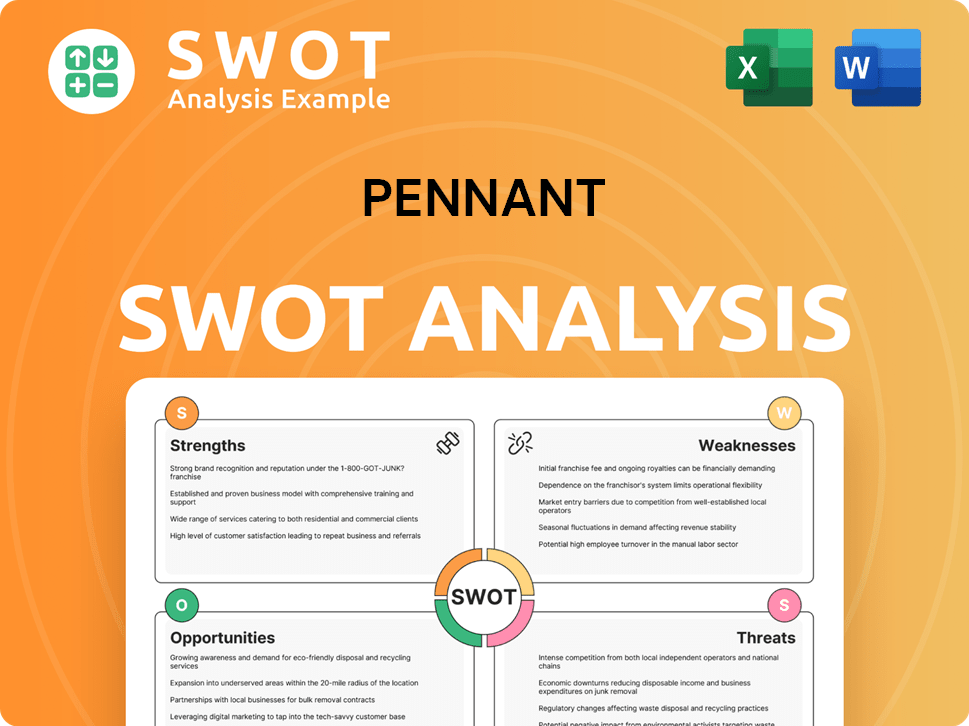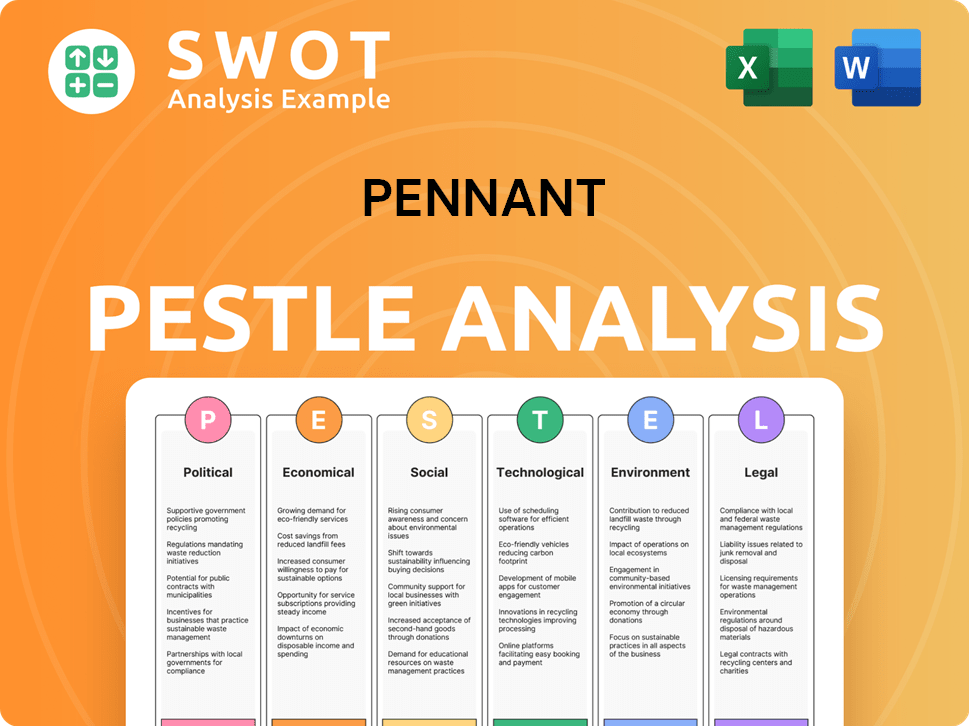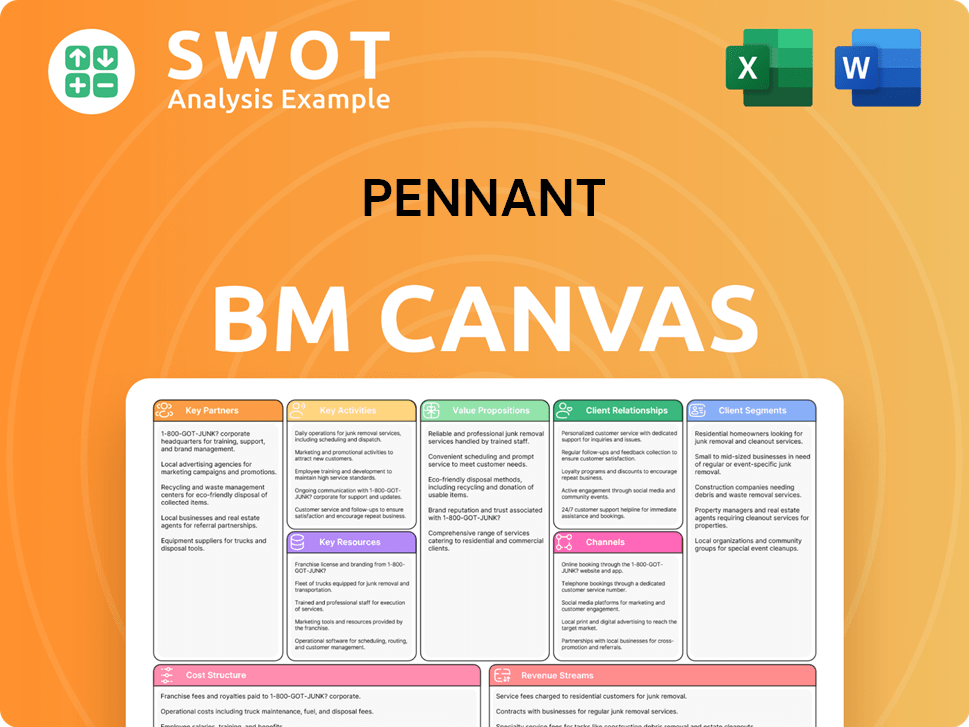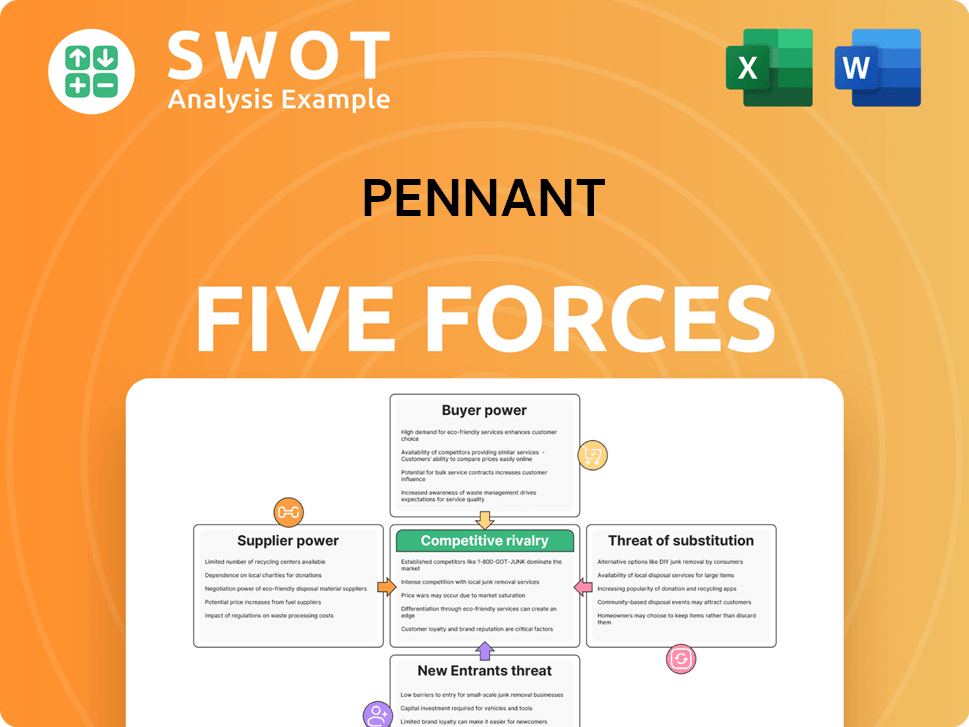Pennant Bundle
Who Really Owns Pennant Company?
Understanding the ownership structure is paramount to grasping the core of any company's strategy and future. The Pennant Group, Inc. (NASDAQ: PNTG), a rapidly expanding healthcare services provider, presents a compelling case study in ownership dynamics. With a decentralized operational model and impressive financial growth, the question of who controls Pennant Company becomes increasingly critical for investors and stakeholders alike.

This exploration into Pennant SWOT Analysis will uncover the intricate details of Pennant Company ownership, from its inception in 2019 to its current status as a publicly traded entity. We'll examine the influence of major shareholders, the roles of the board of directors, and how these factors shape the company's strategic direction. Learn about Pennant Company history, its executives, and the individuals and institutions driving its remarkable success, including its impressive revenue growth and market capitalization.
Who Founded Pennant?
The Pennant Group, Inc. began its journey in 2019. Understanding the initial ownership structure of the company, including the equity split among the founders, requires further investigation of public records, as specific details are not readily available.
The company's operational model emphasizes a decentralized approach. This structure empowers local leaders to manage the individual agencies and communities that make up the Pennant Group.
Key leadership roles were established early on. Danny Walker served as the Chief Executive Officer, and Brent Guerisoli held the position of President as of September 2021. This indicates their significant involvement from the early stages of the company.
Danny Walker was the Chief Executive Officer and Brent Guerisoli was the President in September 2021.
Daniel H. Walker is the largest individual shareholder.
Daniel H. Walker owns 3.95% of the company as of early 2025.
Daniel H. Walker holds 1.36 million shares.
Information about early backers, angel investors, or initial ownership disputes is not publicly detailed.
The founding team focused on providing healthcare services through independent operating subsidiaries.
The Pennant Group, Inc. launched in 2019, with a focus on a decentralized operational model. The company's early leadership included Danny Walker as CEO and Brent Guerisoli as President. As of early 2025, Daniel H. Walker is the largest individual shareholder, holding 1.36 million shares, which represents 3.95% of the company. For more details on the business model, check out the Revenue Streams & Business Model of Pennant.
- The company's structure empowers local leaders.
- The founding vision centered on healthcare services.
- Details on early investors are not publicly available.
- The focus is on clinical excellence and patient-centered care.
Pennant SWOT Analysis
- Complete SWOT Breakdown
- Fully Customizable
- Editable in Excel & Word
- Professional Formatting
- Investor-Ready Format

How Has Pennant’s Ownership Changed Over Time?
The ownership of The Pennant Group (PNTG), a company operating in the healthcare industry, is largely shaped by institutional investors. The evolution of its ownership structure reflects strategic shifts and financial maneuvers. As of May 2025, institutional investors hold a substantial portion of the shares, with approximately 80.51% of the company's stock. This concentration of ownership among institutional entities significantly influences the company's strategic direction and financial decisions.
The company's growth strategy, including acquisitions, has further impacted its ownership dynamics. For example, in 2024 and early 2025, Pennant made significant acquisitions, such as Signature Healthcare at Home's hospice and home health assets. These acquisitions, financed through capital resources like a $250 million credit facility and equity offerings, have led to shifts in equity and potentially attracted new investors. This strategic expansion is a key aspect of the Growth Strategy of Pennant.
| Shareholder Type | Approximate Ownership (May 2025) | Notes |
|---|---|---|
| Institutional Investors | 80.51% | Includes Fidelity, 8 Knots Management, Van Berkom & Associates, BlackRock, and Vanguard. |
| Individual Insiders | 3.98% to 8.25% | Daniel H. Walker is the largest individual shareholder. |
| Public and Retail Investors | 3.67% to 17.32% | Includes individual investors. |
Key institutional shareholders play a vital role in the company's operations. Fidelity Management & Research Co. LLC holds 11.84% of shares, 8 Knots Management LLC holds 8.775%, Van Berkom & Associates, Inc. holds 8.296%, BlackRock Advisors LLC holds 7.629%, and Vanguard Fiduciary Trust Co. holds 6.192%. These holdings demonstrate the confidence these entities have in the company's future.
Institutional investors dominate the ownership structure of The Pennant Group.
- Institutional investors hold approximately 80.51% of the shares.
- Individual insiders and public/retail investors hold the remaining shares.
- Acquisitions and financial strategies influence the ownership distribution.
- This ownership structure impacts decision-making and strategic direction.
Pennant PESTLE Analysis
- Covers All 6 PESTLE Categories
- No Research Needed – Save Hours of Work
- Built by Experts, Trusted by Consultants
- Instant Download, Ready to Use
- 100% Editable, Fully Customizable

Who Sits on Pennant’s Board?
The current board of directors of The Pennant Group, Inc. plays a vital role in guiding the company's strategic direction and ensuring effective governance. As of April 1, 2024, the board included Class I directors Christopher R. Christensen, Dr. John G. Nackel, and Brent J. Guerisoli, whose terms extend through the 2025 fiscal year. Additionally, Stephen M.R. Covey and Suzanne D. Snapper were elected as Class III directors at the May 16, 2025, annual meeting, and will serve until the 2028 Annual Meeting. Brent Guerisoli also holds the positions of CEO and Chairman. Other board members include Mr. Scott E. Lamb, Dr. Gregory K. Morris, MD, and Mr. Barry M. Smith. Understanding the composition of the board is key to understanding Pennant Company's marketing strategy.
The board's committees are essential for overseeing risk management and ensuring that management responds appropriately to various challenges. The board's structure and the roles of its members are important for understanding the company's operational and strategic decisions. There is no publicly available information indicating recent proxy battles, activist investor campaigns, or governance controversies that have significantly shaped decision-making within the company.
| Director | Class | Term Expires |
|---|---|---|
| Christopher R. Christensen | I | 2025 |
| Dr. John G. Nackel | I | 2025 |
| Brent J. Guerisoli | I | 2025 |
| Stephen M.R. Covey | III | 2028 |
| Suzanne D. Snapper | III | 2028 |
| Scott E. Lamb | N/A | N/A |
| Dr. Gregory K. Morris, MD | N/A | N/A |
| Barry M. Smith | N/A | N/A |
The voting structure for the company's common stock is straightforward, with each share entitled to one vote. This 'one-share, one-vote' system applies to all matters put to a stockholder vote, including the election of directors. The absence of cumulative voting means that a majority of shareholders can elect all directors, which can influence the representation of minority shareholders. At the May 16, 2025, Annual Meeting, a significant number of shares were represented, with over 28 million shares participating out of a total of 34.7 million entitled to vote. Stephen M.R. Covey secured 17,627,587 votes, and Suzanne D. Snapper received 25,659,115 votes, demonstrating strong shareholder engagement.
Understanding the board of directors and the voting structure is crucial for assessing the company's governance and potential for shareholder influence.
- The board oversees strategic direction and governance.
- The voting structure follows a one-share, one-vote principle.
- Significant shareholder participation was evident at the 2025 Annual Meeting.
- The board's committees play a key role in risk management.
Pennant Business Model Canvas
- Complete 9-Block Business Model Canvas
- Effortlessly Communicate Your Business Strategy
- Investor-Ready BMC Format
- 100% Editable and Customizable
- Clear and Structured Layout

What Recent Changes Have Shaped Pennant’s Ownership Landscape?
Over the past few years, the ownership profile of the Pennant Company has been significantly shaped by an aggressive growth strategy centered on mergers and acquisitions. In 2024 and early 2025, the company made several key acquisitions, including the purchase of hospice and home health assets from Signature Healthcare at Home for $80 million. This deal alone is projected to boost Pennant's revenue by an additional 13%. Further acquisitions included Nurses on Wheels in Texas in May 2024 and several senior living communities across Arizona, Idaho, Texas, and Wisconsin, demonstrating a clear intent to expand its operational footprint.
The company's leadership structure also reflects these changes, with Brent Guerisoli as CEO and Chairman, and John Gochnour as President and COO. This focus on leadership development is a key driver of its growth trajectory. The Pennant Company ownership structure is evolving, influenced by industry trends, such as increased institutional ownership and consolidation within the healthcare sector. As of May 2025, institutional investors held approximately 80.51% of the company's stock, showing a strong vote of confidence in its strategic direction. For more information about the company's competitors, you can read about the Competitors Landscape of Pennant.
Institutional investors, including Fmr Llc, 8 Knots Management, Llc, Van Berkom & Associates Inc., BlackRock, Inc., and Vanguard Group Inc., have generally increased their stakes, with 100 institutional investors adding shares in Q4 2024. Pennant anticipates total revenue between $800.0 million and $865.0 million for 2025, with adjusted earnings per diluted share between $1.03 and $1.11. The company's strong financial position, including a $250 million credit facility, provides ample resources for future acquisitions, especially in home health, hospice, and senior living. Pennant's decentralized model and focus on local leadership are central to integrating new acquisitions and driving organic growth.
| Key Acquisition | Date | Details |
|---|---|---|
| Signature Healthcare Assets | 2024-Early 2025 | $80 million, seven locations in Oregon, multiple in Washington, and two in Idaho. |
| Nurses on Wheels | May 2024 | Texas-based home health services. |
| Senior Living Communities | Late 2024-Early 2025 | Arizona (128 units), Idaho and Texas (188 units), Wisconsin (125 units). |
Increased institutional ownership is a notable trend. Institutional investors hold a significant portion of the company's stock.
Pennant anticipates strong revenue and earnings. The company ended 2024 with strong cash flows.
The company focuses on acquiring underperforming operations. Targeted areas include home health, hospice, and senior living.
Brent Guerisoli leads the company as CEO and Chairman. Decentralized model and local leadership are key strategies.
Pennant Porter's Five Forces Analysis
- Covers All 5 Competitive Forces in Detail
- Structured for Consultants, Students, and Founders
- 100% Editable in Microsoft Word & Excel
- Instant Digital Download – Use Immediately
- Compatible with Mac & PC – Fully Unlocked

Related Blogs
- What are Mission Vision & Core Values of Pennant Company?
- What is Competitive Landscape of Pennant Company?
- What is Growth Strategy and Future Prospects of Pennant Company?
- How Does Pennant Company Work?
- What is Sales and Marketing Strategy of Pennant Company?
- What is Brief History of Pennant Company?
- What is Customer Demographics and Target Market of Pennant Company?
Disclaimer
All information, articles, and product details provided on this website are for general informational and educational purposes only. We do not claim any ownership over, nor do we intend to infringe upon, any trademarks, copyrights, logos, brand names, or other intellectual property mentioned or depicted on this site. Such intellectual property remains the property of its respective owners, and any references here are made solely for identification or informational purposes, without implying any affiliation, endorsement, or partnership.
We make no representations or warranties, express or implied, regarding the accuracy, completeness, or suitability of any content or products presented. Nothing on this website should be construed as legal, tax, investment, financial, medical, or other professional advice. In addition, no part of this site—including articles or product references—constitutes a solicitation, recommendation, endorsement, advertisement, or offer to buy or sell any securities, franchises, or other financial instruments, particularly in jurisdictions where such activity would be unlawful.
All content is of a general nature and may not address the specific circumstances of any individual or entity. It is not a substitute for professional advice or services. Any actions you take based on the information provided here are strictly at your own risk. You accept full responsibility for any decisions or outcomes arising from your use of this website and agree to release us from any liability in connection with your use of, or reliance upon, the content or products found herein.